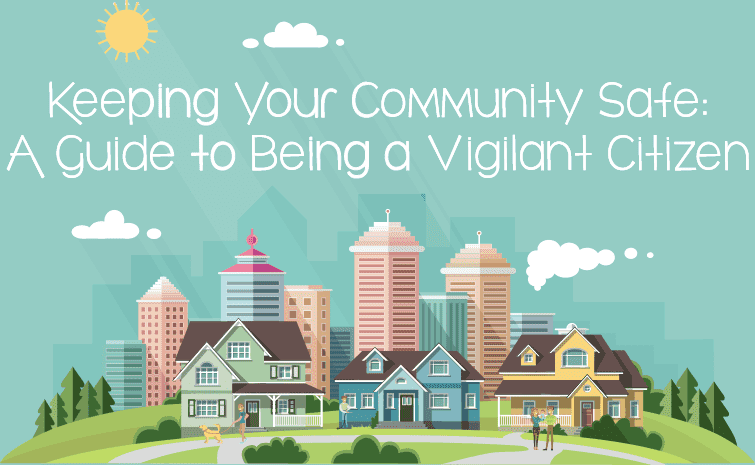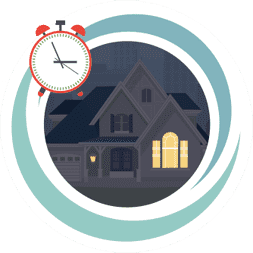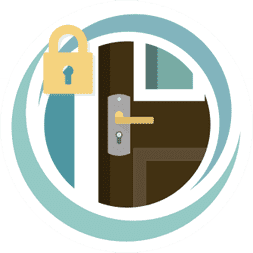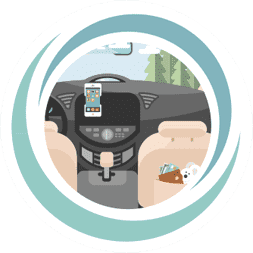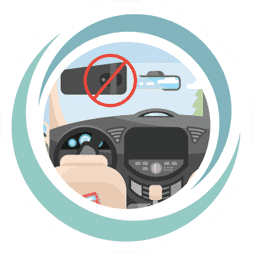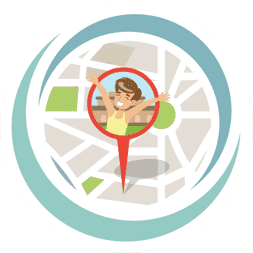Expert Insights on Community Safety
There are many ways you can be a vigilant citizen and keep your family, your neighbors, and yourself safe. We have compiled different pieces of insight from experts in the field to shed light on the subject:

Crime & Neighborhood Safety
The truth is, crime can make its way to any neighborhood, no matter how safe it is. In times of economic distress, people are even more concerned about rising crime in their communities. On the bright side, people can take plenty of preventative measures to protect their homes and neighborhoods. The steps could be as simple as keeping the doors locked or as complex as starting a neighborhood watch program.
Even though no place is immune to crime, teamwork with neighbors and family members can make a difference to minimize it. This guide defines burglary, explains in detail the importance of neighborhood safety, provides tips on keeping your kids safe, and outlines how you can be a proactive member in your community to promote safety.
What Is Burglary?
Property crime can take many different forms, but one of the most common is burglary. The FBI defines burglary as “the unlawful entry of a structure to commit a felony or theft. To classify an offense as a burglary, the use of force to gain entry need not have occurred.”
Break-ins are never fun, and they can be costly. The FBI points out that the average dollar loss per burglary totaled $2,799, adding up to approximately $3.4 billion in property losses. Moreover, nearly 57% of burglaries in 2018 involved forcible entry, with doors kicked in or windows smashed.
No matter how burglars enter, their crimes cause residents to feel violated and on edge. Homeowners and renters should take proper measures to reduce the likelihood of burglaries.
Tips for Keeping your Home & Surroundings Safe
Neighborhood safety requires a team effort. The following tips for working together are simple but effective, making your neighborhood a more enjoyable place to live.
Consider removing your home from Google Maps.
Thieves love to case houses on Google Maps so they can get a good idea of how easy it is to access the property and what the rear is like.
To get your home removed, find your address on Google Maps. Click on the smaller picture of your home to enlarge it. Choose the “Report a Problem” link. It’s tiny and at the bottom right of the picture alongside terms, copyright year, and the image capture date. You have the option to blur your home, any faces, car license plates, or something else. Adjust the view of the image so it’s on the portion you want to blur.
Use smart lights and other devices to create the impression you are home.
Running late or having fun on vacation? No problem. Smart home devices include light bulbs, window blinds, TVs, and radios. Turn them on and off remotely to create the impression you’re home. You can also set them to work at certain times or if motion sensors detect movement.
Devices such as the Ring doorbell cameras even let you talk to someone who is at your door. You can make potential burglars think you’re home and still be 3,000 miles away. These doorbells also come in handy if UPS folks attempt to leave a package. Talk with them live and ask that they hold the box at a facility instead of leaving it in plain view.
Alexa’s drop-in feature is another option to act like you’re home. Suppose you get a notification from your smart doorbell that someone is approaching the door. You don’t recognize the person. One option is to use your smartphone’s Alexa app to “drop in” on your smart speaker at home. Talk away like you’re cooking or on the phone to make a would-be burglar turn back.
Know the people in your neighborhood.
Get to know the people in your neighborhood so you can recognize suspicious people.
Be aware of your neighbor's habits. When are they at work, and do they have small children or teenagers? Are they elderly and in need of extra assistance on occasion? This awareness will make the neighborhood a much tighter community with less neighbor hostility and crime.
Keep your vacation dates off social media.
Many folks share news of upcoming vacations on social media. However, if you do that, you essentially set yourself up as a target for burglars. Criminals rely on public social media profiles like Facebook and Instagram to stalk and intrude homes while residents are away.
Make use of timers.
Timers are great, especially on nights you won't be home. Set a timer to have the lights go on and off at specific times so that it looks like your home is occupied. Many burglars study when people exit and enter their homes, so using timers connected to lights throws them off.
Lock all doors and windows.
Many homes have multiple doors and windows. Burglars need just one unlocked entry point, and it can be easy for residents to overlook one or two locks. For optimal safety, lock all doors and securely fasten all windows. If you have any sliding doors, place a rod in the track to prevent thieves from forcing the door open and entering. Last but not least, consider a video doorbell camera for when you are home alone or not home.
Utilize blinds and curtains.
These guys are especially handy at night because otherwise, people easily see the inside of your home. Potential burglars can track your activities and glimpse where you're putting your valuables, which room you're in, and which rooms are vacant. Keep the blinds closed and the curtains drawn to prevent any creepy stalkers from targeting your home.
Install motion-sensor lights outside of your home.
Burglars don’t like motion-sensor lights since they’re bright and shine a spotlight on illicit activity. They switch on quickly, motivating would-be burglars to flee and never return. These lights are also an excellent way for you to know when someone approaches your home.
Keep your neighbors informed.
It's always smart to get to know your neighbors and reach a level where you can trust at least one. If you plan to be away for a few days, give a copy of your keys to trusted neighbors so they can make sure everything is okay at home.
- Inform a trusted neighbor that you will be away for a few days if there's a vacation coming up.
- Give them a copy of your keys. This way, they can make sure that everything is okay at home.
- Having mail accumulate can be a red flag and invite intruders. Kindly request that your neighbor collects the mail and hold it somewhere safe until you get back.
- If you have a car, you may also want to ask your neighbor to move your car around to make it appear as if you are home.
- Are you a pet owner? Your neighbors can make sure that your pets are safe and sound, and well-fed!
- Of course, it goes the other way, too. If neighbors need help, you can be there for them and report any suspicious behavior around their home if you see it.
- Consider a program such as Neighbors by Ring. You don’t need a Ring device, and neighbors can easily share updates (crime, suspicious people, lost pets, etc.). If you have issues with too many comments or comments that bother you, the app gives you the ability to customize notifications.
- Create a neighborhood calling tree with a few trusted neighbors. Place it somewhere readily accessible so that in case of an emergency, you can quickly contact them.
Be conservative with your pricey possessions.
You probably don’t mean to flaunt significant purchases like a brand-new iMac. Take the time to deconstruct the boxes these purchases came in. Hide the boxes to ensure passers-by can’t easily see or find them.
Get a guard dog.
Not only do dogs make excellent pets, they can be great members of the community. Thieves tend to stay away from homes with loud barking dogs. If you don't have a dog, it couldn't hurt to place a “beware of dog” sign somewhere visible on the outside of your home. A dog doesn’t replace your home security system, but a good guard dog can intimidate intruders and make them think twice. Check out the top 10 best guard dogs!
Start a Neighborhood Watch.
A neighborhood watch program can go a long way toward keeping your home and family safe. The time investment is minimal, and you shouldn’t need to take personal risks. The police will be the ones responsible for investigating suspicious activity and arresting suspects.
The goals of your neighborhood watch should be to facilitate increased awareness of suspicious activity and pave the way for quick communication with the police. The net result: Greatly increased chances of preventing crime. Here are a few steps to starting a neighborhood watch.

Cons include the propensity toward unwanted comments and even racial bias. There can also be way too many comments to deal with. You can customize notifications, but some folks end up quitting the app altogether. Some of your neighbors might not have smartphones, either. You would ideally have a neighborhood watch that is strong, no matter what.
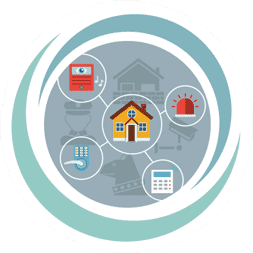
- Briefly go door to door, explain how the neighborhood watch works, and gauge interest. Take note of any neighbors who show extra interest in the program and are eager to help out. You'll want to assign them to crucial roles so that all the efforts do not fall on your shoulders. Distributing power also helps with teamwork and cooperation throughout the neighborhood. If you live in a large community, you can assign geographical locations with specific individuals as the main point of contact for that specific area.
You also need to find a designated coordinator to be the go-to person for representing the neighborhood to the local police. - Get your local police department involved. Work on getting a meeting between the police and your neighborhood watch. Such arrangements are a great way to get to know the officers, learn about crime trends in the area, and brush up on the legal requirements for creating a neighborhood watch. Schedule the meeting two weeks in advance so that there is time for others in the neighborhood to hear about the meeting and get involved.
- Have an action plan in place. After you've established a neighborhood watch, schedule regular meetings to go over goals, progress, concerns, and questions. Reach out to nearby civic groups to expand your network and increase your neighborhood’s involvement in the area.
Keep your yard well maintained.
Well-kept yards and neighborhoods deter criminals. These types of yards indicate involved community members and reduce hiding spots for burglars. Try to keep a clear line of sight to your entryways, so that criminals breaking in are easily visible from across the street. Large bushes and trees that block the view of your house make it a more likely target for thieves as they can remain hidden while breaking in.
If there is an abandoned house or a house up for sale in your neighborhood, then see if anyone in the community is interested in helping to keep its yard maintained. Empty houses offer an easy escape path for criminals. Abandoned houses also make it easy for someone to hide out, study people’s habits, and calculate the best times to break in. Keep the yards of abandoned houses well maintained to deter burglars and make their jobs harder.
Never leave anything out in plain sight inside your car.
Yes, even if the doors are locked! Thieves can break through the windows to take your belongings if they feel motivated enough. Don't give anyone any reason to target your car, even if it's something as simple as a blanket. Thieves may think the blanket is there to hide something valuable beneath it. Keep your vehicle completely clear of your possessions to save you the trouble of recovering your valuables and the inconvenience of having to fix broken car windows. To be extra safe, lock your car's compartment and trunk. This way, if someone somehow gets in the car, they can’t go through these parts of the vehicle.
Do not keep garage door openers in a car parked outside.
If you have a garage but park your car outside, start bringing the garage door opener inside with you. It should become as habitual as grabbing your keys and your purse/wallet, and goes a long way to prevent break-ins. Otherwise, burglars could use the opener to gain access to your garage and possibly your home.
Keep personal information hidden by using a paper shredder.
Identity theft is real—and expensive. Use shredders to conceal your personal information before it makes its way to recycling or garbage bins. Unfortunately, having paperwork with your address, credit card information, bank numbers, passwords, phone number, and the like lying around makes you a new target to burglars. Also consider using a top identity theft service to help monitor all of your personal data and be notified as soon as something suspicious happens.
Get a reliable security system installed.
When used properly, some of the best home security systems can help to improve neighborhood safety. KGW News in Portland, Oregon, corresponded with 86 inmates serving time for burglary. Most said security cameras are a deterrent.
Find out where your local police department is.
You never know when you'll need to visit the police station. Besides, it’s a good idea to drop by and express your desire to keep the neighborhood safe. Don’t hesitate to let the police know about potential dangers such as speeders in areas with children. Everyone benefits when the police are aware of an issue and given a chance to address it. Do keep in mind that the police have many neighborhoods and problems to oversee. It is up to residents to be vigilant citizens and speak up when they need help.
Guarding the Children
In addition to protecting your home, it's also important to be vigilant about your children and their whereabouts. Below are some tips to encourage the safety of kids in your neighborhood, including your children.
Be aware of your children's location.
Have your children ask permission or at least tell you where they are going before leaving the house. Establish a time they need to be home. Have them leave the phone number to where they will be, or give them a cellphone, if possible.
If you use GPS tracking to keep an eye on your children’s location (Android, iOS), let them know. They’ll feel resentful if they later find out you were “spying.” Clear communication is the way to go.
Get your kids well-acquainted with the neighborhood.
Take walks with your kids frequently and show them around the neighborhood on different days and times. This way, if they are ever lost or stumble across a neighbor's kid who may be lost, they can safely find their way home. Also, inform them of potentially unsafe areas. Encourage your children to frequent public areas (avoid alleyways or spaces where they can easily be kidnapped, attacked, or cornered) and be home before dark.
Know your children's friends
Get to know your children's friends and their parents. Try to meet them beforehand and get all their contact information saved to your phone. Ask what the children will be doing at their house and if they'll be supervised. If you're unable to meet the parents first, then try to talk to them over the phone. Issues to consider discussing include guns, pools, trampolines, and dogs. Use your judgment.
Teach problem-solving skills to your children.
Your children will inevitably come across bullies or have confrontations with their friends. Role-play common scenarios that apply to their age group. Teach them to use words to work through any issues rather than resorting to violence. Instill in them that teasing and making fun of others can be hurtful. It does not lead to good friendships.
Give your child a mode of communication.
If your children are old enough to wander off on their own, it may be a good idea to provide them with a cellphone and let them know who they can reach in case of an emergency. This way, they can keep you in the loop while they're out, and you can easily communicate with them when needed. You can even consider a highly ranked medical alert system that calls on emergency responders with the touch of a button.
Set boundaries for where your children can go.
If you live in the city, identify how far away your children can go without you. Just around the block or two blocks? Is it okay for them to cross busy intersections? Is there a dangerous area to avoid? If you live in the country, let them know if there is a river to avoid, or farms with large livestock to stay away from in case the animals charge after them. Also, make sure children are aware of any questionable houses to stay away from, especially abandoned ones.
Neighborhood Safety: A Team Effort
While it's impossible to ward off crime 100 percent of the time, just one person can set an excellent example for an entire neighborhood. Educate yourself on the measures you can take to encourage safety in your area. Your neighbors should follow suit and work with you to make the community a better place. Many of these measures are simple but go a long way.
What to Do When Your Home or Car is Broken Into
Immediately after a break-in, you’re likely to feel confused, angry, and scared. Even if the intruders didn’t steal anything, it’s natural to still feel like you’ve lost something: your peace of mind.
According to our comprehensive Property Crime in America Report about 46 percent of property crime victims say they had packages or deliveries stolen or damaged, while about 43 percent said their car was the target of either theft or damage.
First and foremost, remember to stay calm after a crime occurs. After you’ve documented the extent of the damage, we recommend contacting police and filing a report. If anything highly valuable was stolen, you’ll want to inform police so they can be on the lookout.
For future deterrence and/or peace of mind, one inexpensive and fast way to tighten up the security in your home is to buy a few good security cameras and set them up near high-traffic areas or “danger” zones, so they can keep an eye on things when you’re away, asleep, or busy.
Instead of making huge, sweeping changes like relocating or buying thousands of dollars worth of equipment, a few good indoor and outdoor cams and maybe a smart doorbell from a reputable brand like Ring or Arlo can go a long way toward deterring crime. They’re one of the most convenient ways we’ve found to monitor our home, but do remember they’re not a direct substitute for the human eye; as homeowners, we still have to be vigilant and thoughtful in all aspects of our lives, and protecting our home is no different.
Additional Resources
The National Neighborhood Watch was created by the National Sheriff's Association to encourage local communities to initiate neighborhood watches. Here you'll find help on creating an action plan for your neighborhood watch, how to best implement it, and how to get in contact with local law enforcement agencies.
This is a national nonprofit dedicated to teaching children and their parents how to stay safe. It also focuses on missing children and shaping public policies that keep children safe. You'll find safety kits and articles on how to avoid kidnappers.
Beginner's Guide to Modern Home Security
Modern systems are scalable to meet your needs, and many are easy DIY projects. First, identify your security needs and consider factors such as smart assistants, your goals, and your living situation.
Focus Hope has some great community and safety initiatives. Go here to find help on starting block clubs, neighborhood clean-ups, book clubs, and other activities that strengthen a local community. The group also provides a community safety coordination strategy where you can anonymously report crimes and circulate information on crime trends in your area.
